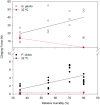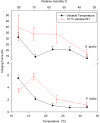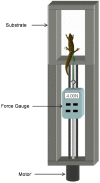Sticky gecko feet: the role of temperature and humidity
- PMID: 18478106
- PMCID: PMC2364659
- DOI: 10.1371/journal.pone.0002192
Sticky gecko feet: the role of temperature and humidity
Abstract
Gecko adhesion is expected to be temperature insensitive over the range of temperatures typically experienced by geckos. Previous work is limited and equivocal on whether this expectation holds. We tested the temperature dependence of adhesion in Tokay and Day geckos and found that clinging ability at 12 degrees C was nearly double the clinging ability at 32 degrees C. However, rather than confirming a simple temperature effect, our data reveal a complex interaction between temperature and humidity that can drive differences in adhesion by as much as two-fold. Our findings have important implications for inferences about the mechanisms underlying the exceptional clinging capabilities of geckos, including whether performance of free-ranging animals is based solely on a dry adhesive model. An understanding of the relative contributions of van der Waals interactions and how humidity and temperature variation affects clinging capacities will be required to test hypotheses about the evolution of gecko toepads and is relevant to the design and manufacture of synthetic mimics.
Conflict of interest statement
Figures




Similar articles
-
Stick or Slip: Adhesive Performance of Geckos and Gecko-Inspired Synthetics in Wet Environments.Integr Comp Biol. 2019 Jul 1;59(1):214-226. doi: 10.1093/icb/icz008. Integr Comp Biol. 2019. PMID: 30873552
-
Effects of temperature on maximum clinging ability in a diurnal gecko: evidence for a passive clinging mechanism?J Exp Zool A Comp Exp Biol. 2005 Sep 1;303(9):785-91. doi: 10.1002/jez.a.210. J Exp Zool A Comp Exp Biol. 2005. PMID: 16106405
-
The effect of variable temperature, humidity, and substrate wettability on Gecko (Gekko gecko) locomotor performance and behavior.J Exp Zool A Ecol Integr Physiol. 2021 Apr;335(4):454-463. doi: 10.1002/jez.2463. Epub 2021 Apr 8. J Exp Zool A Ecol Integr Physiol. 2021. PMID: 33830673
-
Sticking to the story: outstanding challenges in gecko-inspired adhesives.J Exp Biol. 2016 Apr;219(Pt 7):912-9. doi: 10.1242/jeb.080085. J Exp Biol. 2016. PMID: 27030772 Review.
-
A Physical Model Approach to Gecko Adhesion Opportunity and Constraint: How Rough Could It Be?Integr Comp Biol. 2019 Jul 1;59(1):203-213. doi: 10.1093/icb/icz029. Integr Comp Biol. 2019. PMID: 31065674 Review.
Cited by
-
NMR spectroscopy reveals the presence and association of lipids and keratin in adhesive gecko setae.Sci Rep. 2015 Apr 22;5:9594. doi: 10.1038/srep09594. Sci Rep. 2015. PMID: 25902194 Free PMC article.
-
Influence of ambient humidity on the attachment ability of ladybird beetles (Coccinella septempunctata).Beilstein J Nanotechnol. 2016 Sep 22;7:1322-1329. doi: 10.3762/bjnano.7.123. eCollection 2016. Beilstein J Nanotechnol. 2016. PMID: 27826506 Free PMC article.
-
Adhesive interactions of geckos with wet and dry fluoropolymer substrates.J R Soc Interface. 2015 Jul 6;12(108):20150464. doi: 10.1098/rsif.2015.0464. J R Soc Interface. 2015. PMID: 26109635 Free PMC article.
-
Macroscale adhesion of gecko setae reflects nanoscale differences in subsurface composition.J R Soc Interface. 2013 Jan 6;10(78):20120587. doi: 10.1098/rsif.2012.0587. Epub 2012 Sep 19. J R Soc Interface. 2013. PMID: 22993246 Free PMC article.
-
Geckos cling best to, and prefer to use, rough surfaces.Front Zool. 2020 Oct 16;17:32. doi: 10.1186/s12983-020-00374-w. eCollection 2020. Front Zool. 2020. PMID: 33088332 Free PMC article.
References
-
- Autumn K. How gecko toes stick-The powerful, fantastic adhesive used by geckos is made of nanoscale hairs that engage tiny forces, inspiring envy among human imitators. American Scientist. 2006;94:124–132.
-
- Russell AP. Integrative functional morphology of the gekkotan adhesive system (Reptilia : Gekkota). Integrative and Comparative Biology. 2002;42:1154–1163. - PubMed
-
- Pianka ER, Sweet SS. Integrative biology of sticky feet in geckos. Bioessays. 2005;27:647–652. - PubMed
-
- Maderson PFA. Lizard hands and lizard glands: Models for evolutionary study. Forma et Functio. 1970;3:179–204.
-
- Williams EE, Peterson JA. Convergent and Alternative Designs in the Digital Adhesive Pads of Scincid Lizards. Science. 1982;215:1509–1511. - PubMed
Publication types
MeSH terms
Substances
LinkOut - more resources
Full Text Sources

